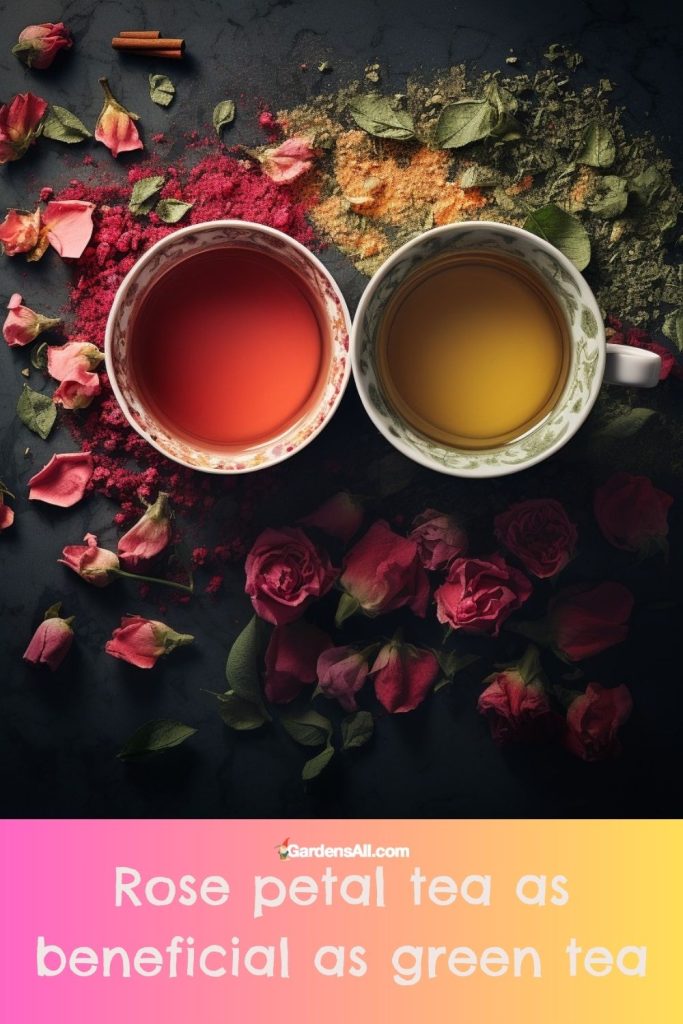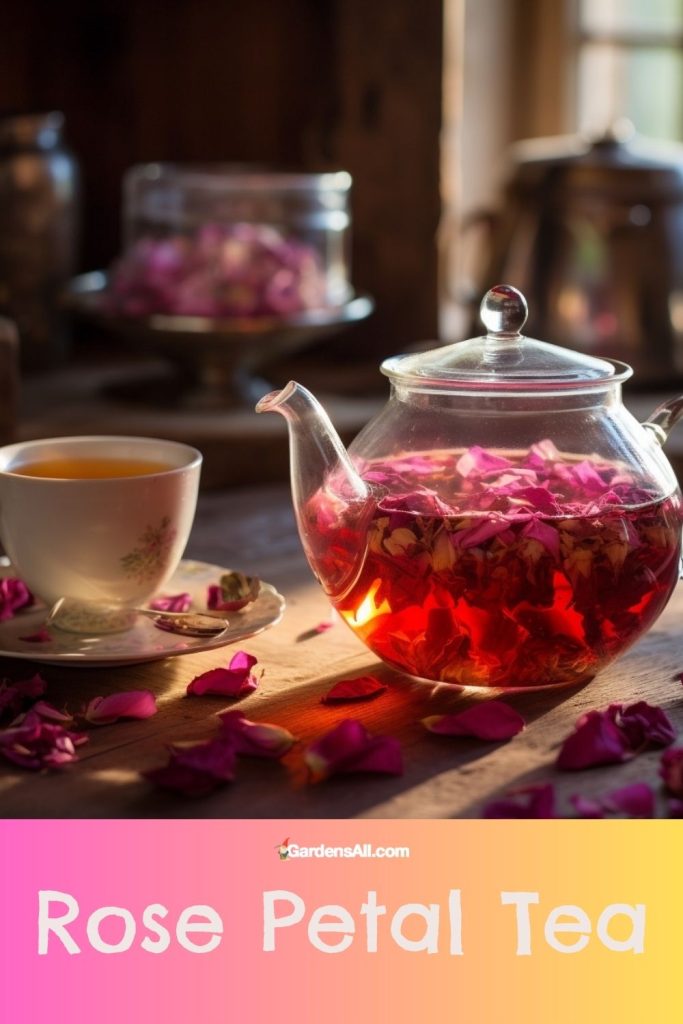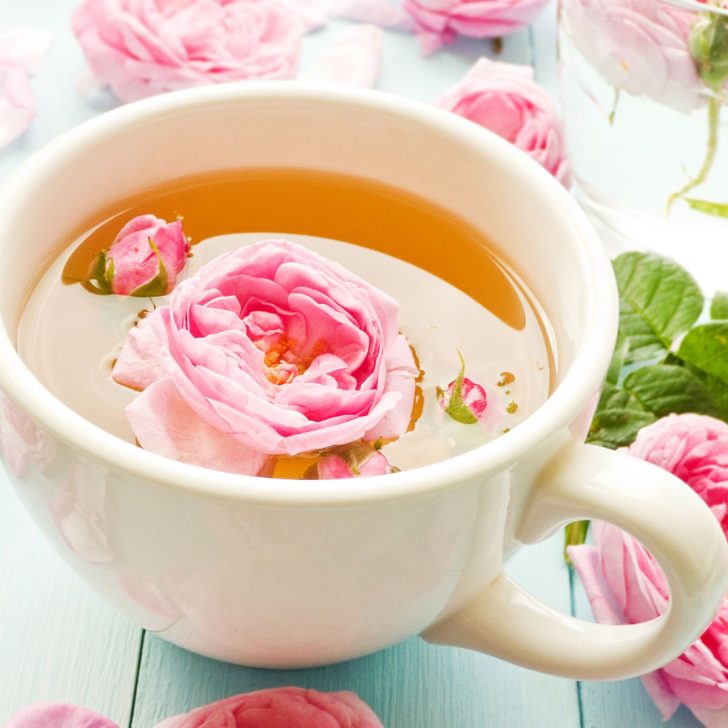A cup of rose petal tea is like a sweet serenade to your senses—its subtle floral aroma soothes and delights as it wafts from the gently pink liquid. Hot or cold, each sip tastes like a blend of tranquility and luxury with a reminder to slow down, unwind and to take time to smell the flowers AND sip tea❣️☕️🌹
Beyond the exquisite charm of roses, this floral infusion offers a plethora of health benefits, from aiding digestion to promoting emotional well-being. In this article, we’ll explore the history, benefits, and brewing techniques of rose petal tea.
Historical Background
The love affair between humans and roses dates back thousands of years, transcending different cultures and civilizations. Rose petals were used in ancient Egyptian rituals, in Roman celebrations, and even as a symbol of love and purity in medieval Europe.
Their use in herbal remedies and beverages like rose petal tea has roots in various traditions, including Ayurveda in India and Traditional Chinese Medicine.
In Iran, there’s a strong bond with the damask rose, (Rosa damascena). Its popularity is not only because of the medicinal effects but also is due to holy beliefs about it.[1]https://www.ncbi.nlm.nih.gov/pmc/articles/PMC3586833/
Because of the low oil content in R. damascena and the lack of natural and synthetic substitutes, essential rose oil of this plant is one of the most expensive ones in the world market.[2]https://www.ncbi.nlm.nih.gov/pmc/articles/PMC3586833/
The Damask Rose oil is one of the most expensive essential oils in the world market.
Reported in the study on The Pharmacological Effects of Rosa damascena.[3]https://www.ncbi.nlm.nih.gov/pmc/articles/PMC3586833/
Health Benefits
It is hard to find studies on the nutrient profile of rose petal tea, and especially of the many varieties of roses. However we did find one that compares the antioxidant benefits of rose petal tea and green tea.[4]https://ift.onlinelibrary.wiley.com/doi/abs/10.1111/j.1365-2621.2006.tb12404.x
| Metric | Rose Petal Tea | Green Tea |
|---|---|---|
| Antioxidant Activity | 712.7 – 1770.7 μM Trolox equivalents (TE) per gram of dry petals | 1227.6 μM TE/g dry weight |
| Total Phenols Content | 50.7 – 119.5 mg gallic acid equivalents (GAE) per gram of dry matter | 62.1 mg GAE/g dry weight |
| Presence of Free Gallic Acid | Rich | Not mentioned |
| Anthocyanins Content | Varies, no clear relationship with antioxidant activity | Not mentioned |
| Sensory Properties | Significantly differs between cultivars | Not mentioned |
| Other Notes | High antioxidant activity in San Francisco, Katharina Zeimet, and Mercedes cultivars | Standard Reference |
The essential oil content of the rose petals collected in cool season is higher than that of the petals collected in warmer season.
REFERENCE: Published study on The effects of harvest date on rose essential oil content.
Research Key Takeaways:
- Antioxidant Activity: Rose petal teas exhibited a wide range of antioxidant activity, and some cultivars even surpassed green tea.
- Total Phenols: The total phenols content in rose teas also varied widely but included ranges that were comparable to, or higher than, green tea.
- Free Gallic Acid: Rose teas were found to be rich in free gallic acid, which provides numerous antioxidant benefits.
- Sensory Properties: Different cultivars of rose petal teas varied significantly in taste, implying a range of options for consumers.
- Potential: The study concludes that dried rose petals can be a source for antioxidant-rich, caffeine-free beverages.
This table highlights how rose petal tea can be comparable to green tea in terms of antioxidant activity and total phenols content, depending on the cultivar used. It also adds the unique benefit of offering a caffeine-free alternative with rich sensory variations.
Rose petal tea is comparable to green tea in terms of antioxidant activity and is a caffeine free alternative.
Study on Rose Petal Tea as an Antioxidant-rich Beverage[6]https://ift.onlinelibrary.wiley.com/doi/abs/10.1111/j.1365-2621.2006.tb12404.x

Rose Petal Nutritional Profile
Rose petals are a good source of vitamin C, polyphenols, and various essential oils. They also contain traces of vitamins A and E, and some minerals like potassium and magnesium.
While the average nutritional profile of herbal teas are often not readily available, we view them as a sort of “microdosing” of nutrients.
Antioxidant Properties
The high level of polyphenols in rose petal tea act as powerful antioxidants that help in combating oxidative stress. Antioxidants protect your cells from damage, potentially reducing the risk of chronic diseases and slowing down the aging process.
Digestive Aid
Rose petal tea has been traditionally used as a digestive tonic. The organic compounds in the petals can help relieve bloating and stomach cramps, making it a soothing drink post-meal.
Emotional Well-being
Known for its calming properties, rose petal tea can act as a natural mood enhancer. Its aroma therapy-like qualities can help reduce levels of stress and anxiety, promoting emotional well-being. Often paired with herbs like chamomile and lemon balm, rose petals also contribute a soothing and calming effect to herbal teas.
Skin Health
Rich in vitamins A and E, rose petal tea can contribute to healthy skin by fighting off free radicals and nourishing skin cells.
Reference: Published study on the Pharmacological Effects of Rosa Damascena[7]https://www.ncbi.nlm.nih.gov/pmc/articles/PMC3586833/
Brewing the Perfect Cup of Rose Petal Tea
As always with herbal teas, use more for a stronger rose petal tea and adjust to your cup size and your preferences.
- Ingredients: Fresh or dried organic rose petals, hot water, optional sweeteners like honey or stevia.
- Proportion: Use about 1-3 teaspoons of crushed dried rose petals or 6 fresh petals or one rinsed rose flower perone cup of water.
- Water Temperature: Heat water to about 140°F (60°C). We use lower temperatures rather than boiling point so as to preserve the maximum nutrients.
- Steeping Time: Steep for 5-15 minutes. Longer steeping times will result in a stronger brew and more nutrient infusion
- Sweeten to Taste: Add a spoon of honey or stevia or any other natural sweetener if desired.
See Infusing Herbs

Rose Petal Tea Recipes
Variations and Pairings
Rose petal tea pairs wonderfully with other herbs and spices. Try blending it with fig leaves tea and dried banana peels for a delightful and mildly sweet fruity tea. Another favorite of ours is rose petal tea with avocado leaves and ginger leaves tea.
You can also add a touch of lemon juice for some added lemon peel zest or mix it with green tea for extra antioxidants. There’s no limit to the possible palate pleasing, body nurturing options!
Here are three different recipes for making rose petal tea, each offering a unique twist to suit different palates. The how-to instructions are the same for each, however, we’ve listed them in each recipe for those who may scan past to their favorite combination.
As with all herbal teas, you can increase or decrease the herbs and steeping time for stronger or milder brews.
1. Classic Rose Petal Tea
Ingredients:
- 1-2 teaspoons of dried organic rose petals
- 1 cup of hot water
- Optional: Honey or stevia for sweetness
Instructions:
- Bring water to a simmer.
- Place the dried rose petals in a teapot or teacup.
- Pour the hot (but not boiling) water over the petals.
- Cover and let steep for 5-7 minutes.
- Strain the tea into a cup, add optional sweeteners, and enjoy!
You can use stainer teapots, strainer teacups or strainer “balls” or spoons.
2. Rose Petal and Mint Tea
Ingredients:
- 1 teaspoon of dried organic rose petals
- 1 teaspoon of dried mint leaves, (we like lemon balm)
- 1 cup of hot water
- Optional: Lemon wedge and honey for sweetness
Instructions:
- Boil water to the desired temperature.
- In a teapot or teacup, combine the rose petals and mint leaves.
- Pour the hot water over the mixture.
- Cover and let steep for 5-7 minutes.
- Strain the tea, add a lemon wedge and optional sweeteners, then enjoy!
3. Rose Petal and Chamomile Blend
Ingredients:
- 1 teaspoon of dried organic rose petals
- 1 teaspoon of dried chamomile flowers
- 1 cup of hot water
- Optional: Honey or stevia for sweetness
Instructions:
- Boil water to the desired temperature.
- In a teapot or teacup, mix the rose petals and chamomile flowers.
- Pour the hot water over the blend.
- Cover and let steep for 5-7 minutes.
- Strain the tea into a cup, add optional sweeteners, and enjoy!
Feel free to customize these recipes according to your taste. You can also experiment with other herbs and spices to make your own signature blend. Enjoy your rose petal tea journey!
Rose Petal Tea in Summary
In our fast-paced lives, the slow luxury of a cup of rose petal tea can be just the pause we need—a moment of respite, a connection to nature, and a token of self-care. Its exquisite aroma and array of health benefits make it a drink to be savored and celebrated. So the next time you’re looking for a beverage that offers both pleasure and wellness, consider the timeless elegance of rose petal tea.
Meanwhile, we were curious, so including this, in case you also wanted to know…
What is Free Gallic Acid?
Gallic acid is mentioned earlier under ‘Research Key Takeaways’, as an organic acid that is widely found in plants and is known for its antioxidant properties. The term “free gallic acid” refers to gallic acid that is not bound to other molecules and is therefore readily available for absorption and utilization by the body. In contrast, “bound gallic acid” is attached to other molecules, often as part of larger tannin compounds, and may not be as easily absorbed or utilized.
Free Gallic Acid Properties and Benefits
- Antioxidant: Gallic acid is a potent antioxidant that can help neutralize free radicals in the body, thus potentially reducing the risk of diseases related to oxidative stress.
- Anti-inflammatory: It has anti-inflammatory properties and may help in reducing inflammation in the body.
- Antimicrobial: Gallic acid also has antimicrobial characteristics that can be effective against a range of bacteria and fungi.
- Anti-cancer: Some studies suggest that gallic acid may have anti-cancer properties, although more research is needed to substantiate these claims.
- Cardiovascular Health: The antioxidant and anti-inflammatory properties of gallic acid can contribute to cardiovascular health by reducing oxidative stress on heart tissues and blood vessels.
What Contains Gallic Acid?
Gallic acid is commonly found in a variety of foods and herbs, including teas, grapes, berries, and oak bark. In the context of rose petal tea, the presence of free gallic acid means that the tea could offer readily available antioxidant benefits.
Bioavailability:
Being “free,” the gallic acid in rose petal tea is more readily bioavailable, which means that it can be more easily absorbed and utilized by the body compared to its bound form. This increases the potential health benefits of the tea, especially its antioxidant properties.
To summarize, free gallic acid is a readily available form of the organic acid that contributes to the antioxidant, anti-inflammatory, and antimicrobial properties of rose petal tea.
I’m LeAura Alderson, a garden, herb and plant enthusiast with a passion for discovering the many edible and medicinal benefits of the plants all around us, including the weeds! I’m a writer, editor and media publisher for our family of websites.
While I was certified in fitness and life coaching, I am NOT a health practitioner. However, I’m a lifelong health enthusiast, with a keen interest in healthy, organic foods and making home remedies and the content we share is from our own experience and usage as well as that extracted from scientific research so that you can explore further on your own.
Always seek the advice and guidance of your health practitioners first and foremost.
As a family we’re steadily expanding our gardening, experimentation and knowledge around all things gardening, edible landscaping, fresh organic foods and self sustainability with farming in our future. I also own and manage iCreateDaily.com, a site all about transformation through creation, and the power of positivity, optimism and mindset.
References

